Translate this page into:
Howard-Dubois procedure with distal partial nail removal to treat distal nail embedding
Corresponding author: Prof. Jun Young Kim, Department of Dermatology, School of Medicine, Kyungpook National University, Kyungpook National University Hospital, Daegu, Republic of Korea, 198kjy@hanmail.net
-
Received: ,
Accepted: ,
How to cite this article: Ha NG, Kim JY. Howard-Dubois procedure with distal partial nail removal to treat distal nail embedding. Indian J Dermatol Venereol Leprol 2023;89:927
Sir,
A 42-year-old male patient visited our department with a history of lack of growth of the right great toenail for seven years. There was a history of fall of a heavy object on his right great toe 7 years back which has failed to grow back. He has not required nail trimming in the affected nail in this period. The great toe had mild hallux deformity and the nail showed shortening and diffuse thickening of nail plate, and a transverse white rim at the distal edge with multiple less conspicuous transverse white lines. The lateral and distal nail folds of the affected toe were thickened & mildly tender on deep pressure. [Figure 1a]. Following a clinical diagnosis of distal nail embedding, surgical treatment using the Howard-Dubois procedure was performed to relieve symptoms. A 7 mm-width crescent of soft tissue on the tip of the great toe was removed with a fish-mouth incision. Further, partial nail removal was performed at the distal third of the nail, and curettage of the medial and lateral nail bed was performed [Figures 1b to d]. Postoperative pain was well controlled with analgesics. At his 4 months’ follow up, the nail showed growth and there was no fold tenderness but the thickening of distal nail fold persisted [Figure 2b]. At his 12 months follow-up, the toenail grew further; however, the transverse lines appeared again, and the toenail had xanthochromia [Figure 2c]. After 28 months of treatment, his right great toenail grew well over the distal nail fold with mild lateral deviation [Figure 2d]. No recurrence of embedding was observed and the patient was satisfied with the well-growing nail.

- Transverse rim at the distal edge of the right great toenail with nail shortening, thickening and discolouration

- Prior to surgical intervention, an incision line was drawn with a 7 mm-width crescent shape parallel to the distal and lateral nail folds around the toe tip, and a mark is left on the distal third of the toenail
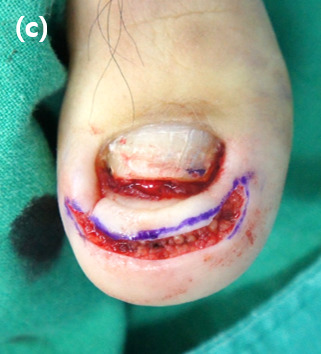
- Sufficient soft tissue is removed in a wedge shape, the distal third of the toenail is removed with curettage of the nail bed
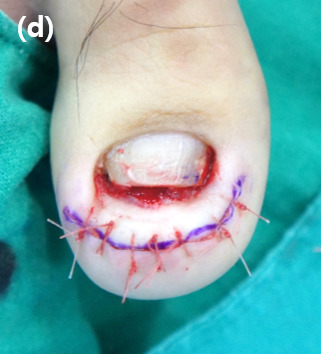
- Pulling down of the thickened distal pulp by the sutures
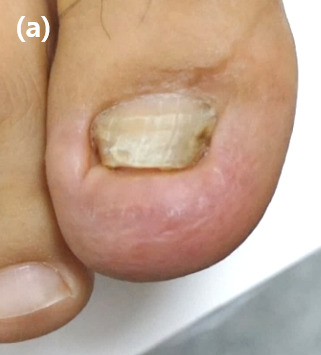
- 2 weeks postoperatively, the distal pulp is slightly swollen, but the toenail has grown
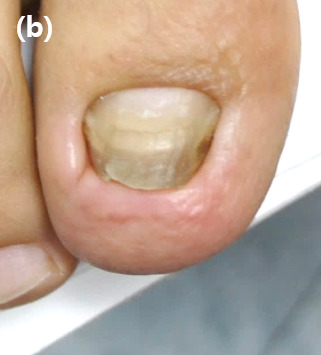
- 4 months postoperatively, the toenail has grown consistently, but with mild obstruction due to the slightly thickened distal pulp
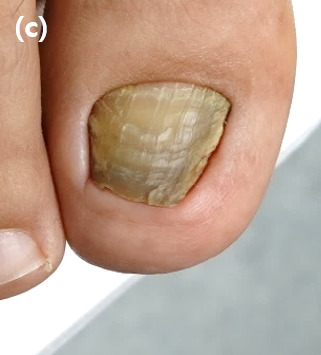
- 12 months postoperatively, the toenail is seen to grow further, however, transverse lines appear, and a yellow-brown nail colour change is observed
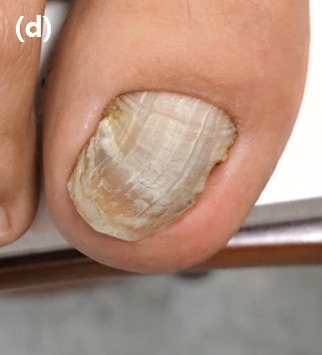
- 28 months postoperatively, the toenail has grown well over the distal pulp and shows mild lateral deviation
When distal nail embedding occurs, a thickened distal nail fold blocks the nail plate, preventing normal nail growth. As the nail grows and irritates the surrounding skin, pain, discomfort in daily life and local infection can develop.1 Distal nail embedding is treated as a form of ingrown toenail because the toenails do not grow well due to the hypertrophic distal nail fold.2 Therefore, when treating distal nail embedding, it is important not only to remove the enlarged periungual tissue but also to promote nail growth. When the patient is asymptomatic or complains of slight pain, conservative treatment can be performed.1 Applying 50% urea ointment or trichloroacetic acid reduces the thickened tip of the toe while placing cotton under the toenail allows the toenail to grow back.3 When the patient complains of severe pain, surgical treatment to directly remove hypertrophic tissue is preferred; Howard-Dubois procedure is one such technique.2 Total nail avulsion with Howard-Dubois procedure is usually recommended to promote new growth of the toenail.4 However, total nail avulsion has a risk of recurrence after treatment as the counterforce of the plate that prevents upward displacement of the nail unit while walking is lost. Instead, freshening up the periphery of the nail bed allows for a better nail plate growth as seen in our case.
Declaration of patient consent
The authors certify that they have obtained all appropriate patient consent.
Financial support and sponsorship
Nil.
Conflict of interest
There are no conflicts of interest.
References
- Best way to treat an ingrown toenail. Dermatol Clin. 2015;33:277-82.
- [CrossRef] [PubMed] [Google Scholar]
- Treatment of nail fold hypertrophy by combining conservative techniques. Skin Appendage Disord. 2021;7:373-6.
- [PubMed] [Google Scholar]
- A new perspective on the nail plate for treatment of ingrown toenail. Dermatol Pract Concept. 2018;8:22-7.
- [PubMed] [Google Scholar]
- Growth rate of human fingernails and toenails in healthy American young adults. J Eur Acad Dermatol Venereol. 2010;24:420-3.
- [CrossRef] [PubMed] [Google Scholar]






